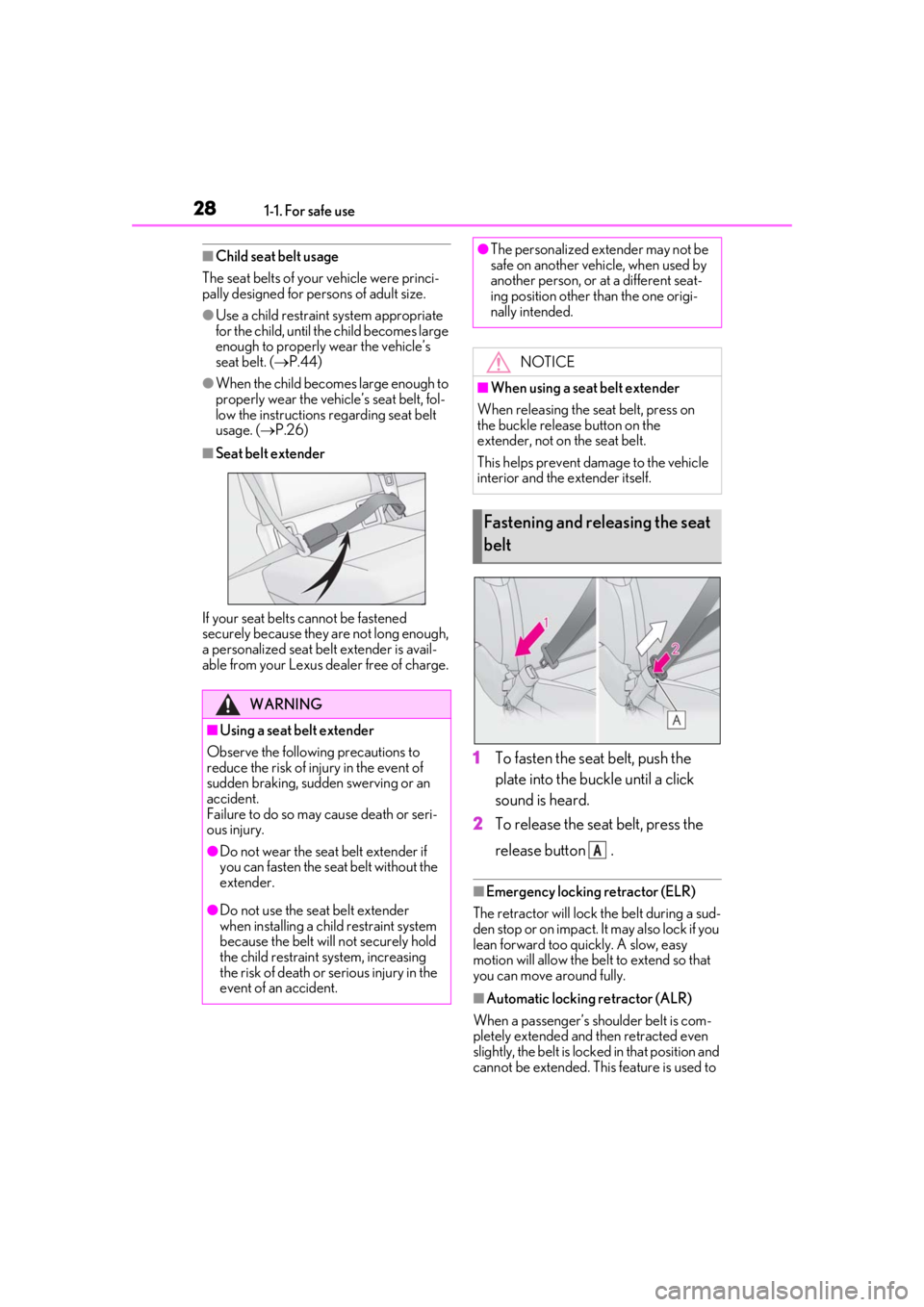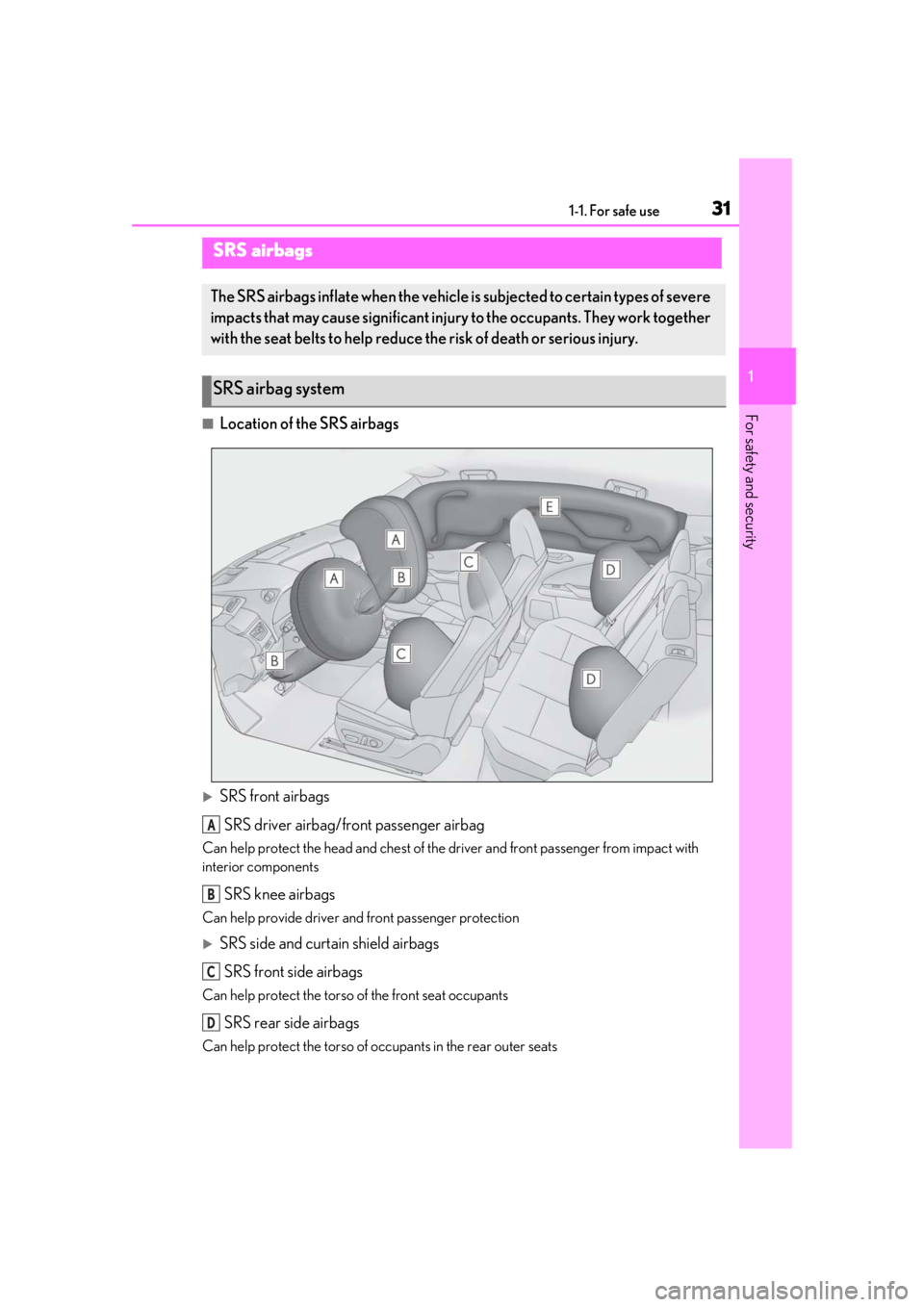2019 LEXUS UX250H interior
[x] Cancel search: interiorPage 1 of 476

UX250h_OM_OM76266U_(U)
1
2
3
4
5
6
7
8
9
Pictorial indexSearch by illustration
For safety
and securityMake sure to read through them
(Main topics: Child seat, theft deterrent system)
Vehicle status
information and
indicatorsReading driving-related information
(Main topics: Meters, multi-information display)
Before drivingOpening and closing the doors and windows,
adjustment before driving
(Main topics: Keys, doors, seats)
DrivingOperations and advice which are necessary for driving
(Main topics: Starting hybrid system, refueling)
Interior featuresUsage of the interior features
(Main topics: Air conditioner, storage features)
Maintenance
and careCaring for your vehicle and maintenance procedures
(Main topics: Interior and exterior, light bulbs)
When trouble
arisesWhat to do in case of malfunction and emergency
(Main topics: 12-volt battery discharge, flat tire)
Vehicle
specificationsVehicle specifications, customizable features
(Main topics: Fuel, oil, tire inflation pressure)
For ownersReporting safety defects for U.S. owners, and seat belt,
SRS airbag and headlight aim instructions for Canadian
owners
IndexSearch by symptom
Search alphabetically
Page 3 of 476

3TABLE OF CONTENTS
1
2
3
4
5
6
7
8
9
4-1. Before drivingDriving the vehicle ........................ 152
Cargo and luggage ...................... 157
Vehicle load limits ......................... 160
Trailer towing .................................. 160
Dinghy towing ................................. 161
4-2. Driving procedures Power (ignition) switch ............... 162
EV drive mode ............................... 165
Hybrid transmission ..................... 167
Turn signal lever.............................. 171
Parking brake ................................. 172
Brake Hold....................................... 175
ASC (Active Sound Control) .. 176
4-3. Operating the lights and wipers Headlight switch ............................ 177
Automatic High Beam ................ 180
Fog light switch .............................. 183
Windshield wipers and washer 184
Rear window wiper and washer ............................................................ 188
4-4. Refueling Opening the fuel tank cap......... 190
4-5. Using the driving support systems Lexus Safety System+2.0 .......... 192
PCS (Pre-Collision System)..... 198
LTA (Lane Tracing Assist)........ 205
RSA (Road Sign Assist) .............. 214
Dynamic radar crui se control with
full-speed range.......................... 216
BSM (Blind Spot Monitor) ....... 226
PKSA (Parking Support Alert) 231Intuitive parking assist .................
232
RCTA (Rear Cross Traffic Alert) function.......................................... 239
PKSB (Parking Support Brake) 243
Parking Support Brake function (static objects) ............................. 247
Parking Support Brake function (rear-crossing vehicles) .......... 252
Driving mode select switch ..... 255
Driving assist systems ................ 256
4-6. Driving tips Hybrid vehicle driving tips ......... 261
Winter driving tips ....................... 263
Utility vehicle precautions........ 266
5-1. Remote Touch Remote Touch............................... 270
5-2. Lexus Climate Concierge Lexus Climate Concierge......... 274
5-3. Using the air conditioning system and defogger
Automatic air conditioning system.......................................................... 276
Heated steering wheel/seat heat- ers/seat ventilators................... 286
5-4. Using the interior lights Interior lights list ........................... 290
5-5. Using the storage features List of storage features .............. 293
Luggage
compartment features
.......................................................... 296
5-6. Using the other interior features Other interior features ............... 301
Garage door opener .................... 311
4Driving
5Interior features
Page 4 of 476

4TABLE OF CONTENTS
Compass...........................................317
6-1. Maintenance and care Cleaning and protecting the vehi-cle exterior ................................... 322
Cleaning and protecting the vehi- cle interior .................................... 325
6-2. Maintenance Maintenance requirements ..... 328
General maintenance ................ 329
Emission inspection and mainte- nance (I/M) programs ............. 331
6-3. Do-it-yourself maintenance Do-it-yourself service precautions........................................................... 333
Hood.................................................. 335
Positioning a floor jack............... 336
Engine compartment.................. 337
12-volt battery................................ 342
Tires ................................................... 345
Replacing the tire ......................... 355
Tire inflation pressure .................. 361
Wheels.............................................. 363
Air conditioning filter..................364
Cleaning the hybrid battery (trac- tion battery) air intake vent and fil-
ter..................................................... 365
Electronic key battery ................ 368
Checking and replacing fuses 370
Headlight aim................................. 372
Light bulbs ....................................... 3747-1. Essential information
Emergency flashers .................... 378
If your vehicle has to be stopped in an emergency ............................ 378
If the vehicle is trapped in rising water .............................................. 379
7-2. Steps to take in an emergency If your vehicle needs to be towed........................................................... 381
If you think something is wrong .......................................................... 385
If a warning light turns on or a warn- ing buzzer sounds..................... 386
If a warning messa ge is displayed
.......................................................... 395
If you have a flat tire .................... 399
If the hybrid syst em will not start
.......................................................... 400
If you lose your keys.................... 402
If the fuel filler door cannot be opened .......................................... 402
If the electronic key does not oper- ate properly ................................. 403
If the 12-volt battery is discharged .......................................................... 405
If your vehicle overheats ............ 410
If the vehicle becomes stuck ..... 413
8-1. Specifications Maintenance data (fuel, oil level, etc.) .................................................. 416
Fuel information............................ 423
Tire inform
ation ............................ 425
6Maintenance and care
7When trouble arises
8Vehicle specifications
Page 20 of 476

20Pictorial index
■Interior
SRS airbags..................................................................................................................P.31
Floor mats ....................................................................................................................P.24
Front seats .................................................................................................................. P. 131
Rear seats ..................................................................................................................P.1 32
Head restraints ........................................................................................................ P.136
Seat belts ..................................................................................................................... P.26
Console box.............................................................................................................P.294
Inside lock buttons ................................................................................................... P.110
Cup holders .............................................................................................................P.294
Assist grips ................................................................................................................. P. 311A
B
C
D
E
F
G
H
I
J
Page 21 of 476

21Pictorial index
■Ceiling
Garage door opener buttons*1............................................................................ P.311
Inside rear view mirror ..........................................................................................P.140
Sun visors ...................................................................................................................P. 301
Vanity mirrors ..........................................................................................................P.301
Interior light
*2.......................................................................................................... P.291
Personal lights.........................................................................................................P.292
Moon roof switches
*1............................................................................................. P.147
Door-linked interior light switch ........................................................................ P.291
“SOS” button
*1...........................................................................................................P.56
*1: If equipped
*2: The illustration shows the front, but they are also equipped in the rear.
A
B
C
D
E
F
G
H
Page 28 of 476

281-1. For safe use
■Child seat belt usage
The seat belts of your vehicle were princi-
pally designed for persons of adult size.
●Use a child restraint system appropriate
for the child, until the child becomes large
enough to properly wear the vehicle’s
seat belt. ( P.44)
●When the child becomes large enough to
properly wear the vehicle’s seat belt, fol-
low the instructions regarding seat belt
usage. ( P.26)
■Seat belt extender
If your seat belts cannot be fastened
securely because they are not long enough,
a personalized seat belt extender is avail-
able from your Lexus de aler free of charge.
1To fasten the seat belt, push the
plate into the buckle until a click
sound is heard.
2
To release the seat belt, press the
release button .
■Emergency locking retractor (ELR)
The retractor will lock the belt during a sud-
den stop or on impact. It may also lock if you
lean forward too quickly. A slow, easy
motion will allow the belt to extend so that
you can move around fully.
■Automatic locking retractor (ALR)
When a passenger’s shoulder belt is com-
pletely extended and then retracted even
slightly, the belt is lock ed in that position and
cannot be extended. This feature is used to
WARNING
■Using a seat belt extender
Observe the following precautions to
reduce the risk of injury in the event of
sudden braking, sudden swerving or an
accident.
Failure to do so may cause death or seri-
ous injury.
●Do not wear the seat belt extender if
you can fasten the seat belt without the
extender.
●Do not use the seat belt extender
when installing a child restraint system
because the belt will not securely hold
the child restraint system, increasing
the risk of death or serious injury in the
event of an accident.
●The personalized extender may not be
safe on another vehi cle, when used by
another person, or at a different seat-
ing position other than the one origi-
nally intended.
NOTICE
■When using a seat belt extender
When releasing the seat belt, press on
the buckle release button on the
extender, not on the seat belt.
This helps prevent damage to the vehicle
interior and the extender itself.
Fastening and releasing the seat
belt
A
Page 31 of 476

311-1. For safe use
1
For safety and security■Location of the SRS airbags
SRS front airbagsSRS driver airbag/front passenger airbag
Can help protect the head and chest of the driver and front passenger from impact with
interior components
SRS knee airbags
Can help provide driver and front passenger protection
SRS side and curtain shield airbagsSRS front side airbags
Can help protect the torso of the front seat occupants
SRS rear side airbags
Can help protect the torso of oc cupants in the rear outer seats
SRS airbags
The SRS airbags inflate when the vehicle is subjected to certain types of severe
impacts that may cause significant injury to the occupants. They work together
with the seat belts to help reduce the risk of death or serious injury.
SRS airbag system
A
B
C
D
Page 33 of 476

331-1. For safe use
1
For safety and security
Rear side airbags
Side impact sensors (front door)
Your vehicle is equipped with ADVANCED AIRBAGS designed based on the US
motor vehicle safety standards (FMVSS208). The airbag sensor assembly (ECU)
controls airbag deployment based on information obtained from the sensors etc.
shown in the system components diagram above. This information includes crash
severity and occupant information. As the airbags deploy, a chemical reaction in
the inflators quickly fills the airbags with no n-toxic gas to help restrain the motion of
the occupants.
■If the SRS airbags deploy (inflate)
●Slight abrasions, burns, bruising etc., may
be sustained from SRS airbags, due to the
extremely high speed deployment (infla-
tion) by hot gases.
●A loud noise and white powder will be
emitted.
●Parts of the airbag module (steering
wheel hub, airbag cover and inflator) as
well as the front seat s, parts of the front
and rear pillars, and roof side rails, may
be hot for several minutes. The airbag
itself may also be hot.
●The windshield may crack.
●The hybrid system will be stopped and
fuel supply to the engine will be stopped.
( P.68)
●All of the doors will be unlocked.
( P.109)
●The brakes and stop lights will be con-
trolled automatically. ( P.257)
●The interior lights will turn on automati-
cally. ( P.291)
●The emergency flashers will turn on auto-
matically. ( P.378)
●For Lexus Enform Safety Connect sub-
scribers, if any of the following situations
occur, the system is designed to send an
emergency call to the response center,
notifying them of the vehicle’s location
(without needing to push the “SOS” but-
ton) and an agent will attempt to speak
with the occupants to ascertain the level
of emergency and assi stance required. If
the occupants are unable to communi- cate, the agent automatically treats the
call as an emergency and helps to dis-
patch the necessary emergency services.
(
P.56)
• An SRS airbag is deployed.
• A seat belt pretensioner is activated.
• The vehicle is involved in a severe rear- end collision.
■SRS airbag deployment conditions (SRS
front airbags)
●The SRS front airbags will deploy in the
event of an impact that exceeds the set
threshold level (the level of force corre-
sponding to an approximately 12 - 18
mph [20 - 30 km/h] frontal collision with
a fixed wall that does not move or
deform).
However, this threshold velocity will be con-
siderably higher in the following situations:
• If the vehicle strikes an object, such as a parked vehicle or sign pole, which can
move or deform on impact
• If the vehicle is involved in an underride collision, such as a collision in which the
front of the vehicle underrides, or goes
under, the bed of a truck
●Depending on the type of collision, it is
possible that only the seat belt preten-
sioners will activate.
●The SRS front airbags for the front pas-
senger will not activate if there is no pas-
senger sitting in the front passenger seat.
However, the SRS front airbags for the
front passenger may deploy if luggage is
put in the seat, even if the seat is unoccu-
pied.
Q
R